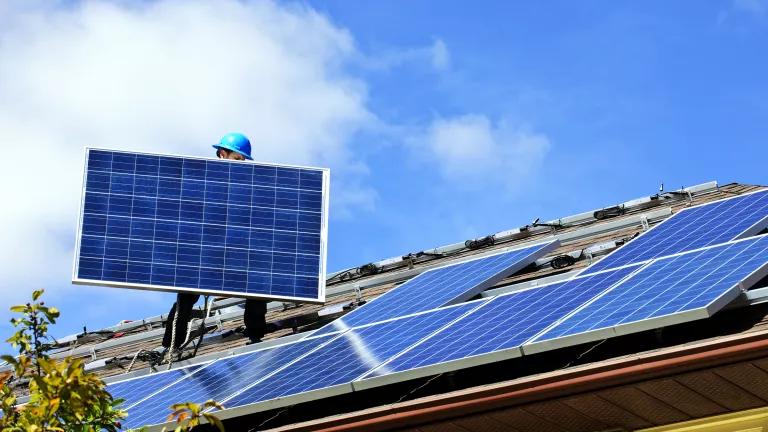Should You Go Solar?
Harnessing power from the sun reduces your reliance on fossil fuels, but it can come with a price tag. How to decide if it’s worth it to you.

Solar power sounds like a genius, obvious way to save the planet—after all, solar is clean and renewable. “If you can offset your home energy consumption, that might mean eliminating a quarter to a third of your carbon footprint,” says Jay Orfield, a renewable energy analyst at NRDC. But even Orfield tempers his enthusiasm with a little pragmatism. “One person getting solar is just that—one person of more than seven billion in the world,” he says. “But if you and your neighbors and their neighbors do this, the benefits add up—it becomes a nontrivial measure that can significantly reduce carbon emissions.” Current methods of harnessing solar can be expensive, and the options complex. Here’s how to figure out whether it makes sense for you.
Check your house.
You can’t stick solar panels on any old roof. The ideal one for placing photovoltaic (PV) panels is south-facing, free of shade, and new enough that it won’t need to be replaced in the next few years. If you’re building a new home, make it energy efficient and install the panels as the roof is built, saving you the engineering and installation costs that a retrofit would require.
Pick your plan.
The bulk of solar options are available only to people who own their homes. If you do, solar providers can offer you a system with the right number of panels to power your house, based on how much energy you consume, your local climate, and other factors. They generally sell the systems outright or with financing or offer a leasing program. In some states, there’s another option, known as a power purchase agreement (PPA). With a PPA, a solar provider will install panels on your house for free, then sell the electricity they generate back to you at a competitive rate. In all cases, it’s imperative to read the fine print (and there may be a lot of it) about fees and the exact terms, as you would with any big or long-term financial commitment. “Remember, these companies are there to make a profit,” says Orfield.
Calculate the costs and benefits.
Solar systems are not cheap. A recent study from the National Renewable Energy Laboratory pegged the average cost of a small-scale PV system at around $3,900 per kilowatt. Although each house is different, Orfield gave a rough estimate: “An average-size house in Denver would need a seven-kilowatt system, while one in Charlotte would need an eight-kilowatt system.” In general, though, you could be looking at around $30,000 before rebates (which can be significant; more on that later). So how long will it take for your new solar power to offset that cost? The frustrating answer is, it depends. “As a rule of thumb, if you have the luxury or ability to look at a long-term horizon, like 20 years, solar panels are going to be a win,” says Orfield. “But the question is, how quickly do you need that return? In places where the cost of electricity is higher, the investment is paid back much more quickly.” One tool Orfield recommends (though he points out that it is run by a solar provider) offers a jumping-off point for comparing solar production and utility rates state by state.
Get money back.
Environmental groups and the solar industry have successfully pushed the government to help make solar more affordable—with the goal of eventually reaching parity with more traditional sources, Orfield says. One big help: the federal solar investment tax credit. If you buy panels (but not if you lease them or do a PPA), you can deduct 30 percent of the cost from your federal income taxes. Keep an eye out for other deals—there are state- and city-specific rebates—and if you’ve done your homework, pounce when you spot a good offer. The best times to check are at the beginning of the year or the start of a government legislative session. “They’ll make a certain amount of money available, and when it’s gone, it’s gone,” Orfield says.
Consider community.
So you rent an apartment, have an old roof that slants due north, or don’t want to spend the money for your own system? Community solar power is a promising new option. In these projects, also known as community solar gardens, utility companies, nonprofits, or businesses such as the Clean Energy Collective build a giant solar-panel system on their own site. Then energy consumers can rent panels within that system, and the power generated from those panels will often directly offset their electric bills. Currently there are almost 100 community solar programs across 25 states, with Minnesota, Massachusetts, Colorado, California, and Texas leading the way.
This NRDC.org story is available for online republication by news media outlets or nonprofits under these conditions: The writer(s) must be credited with a byline; you must note prominently that the story was originally published by NRDC.org and link to the original; the story cannot be edited (beyond simple things such as grammar); you can’t resell the story in any form or grant republishing rights to other outlets; you can’t republish our material wholesale or automatically—you need to select stories individually; you can’t republish the photos or graphics on our site without specific permission; you should drop us a note to let us know when you’ve used one of our stories.
A Consumer Guide to the Inflation Reduction Act
Can Hydrogen Help Combat the Climate Crisis?
What’s the Most Energy-Efficient Water Heater?